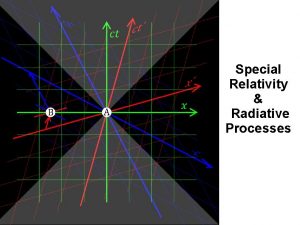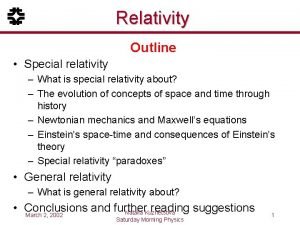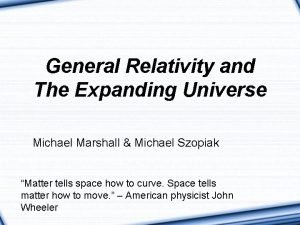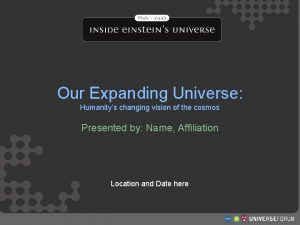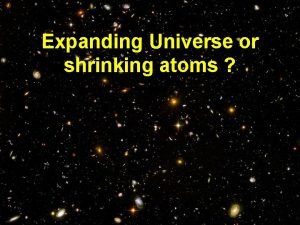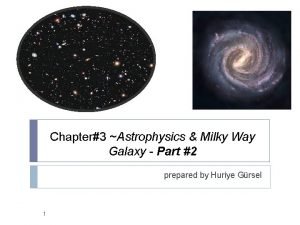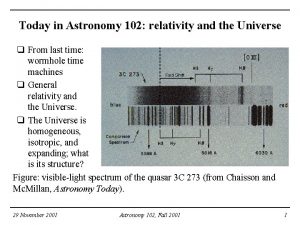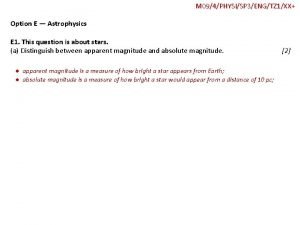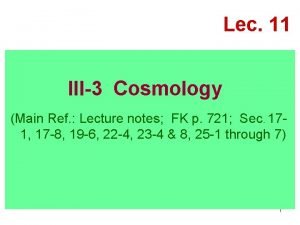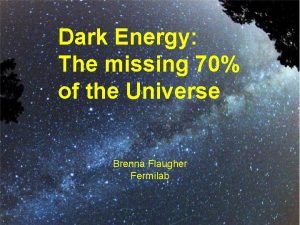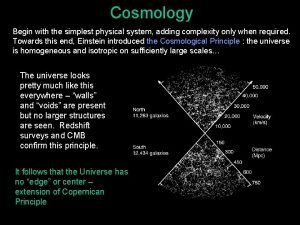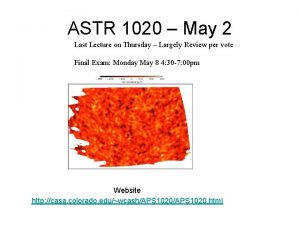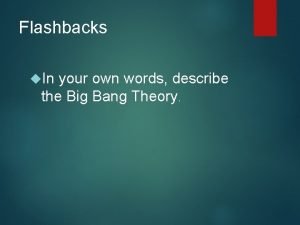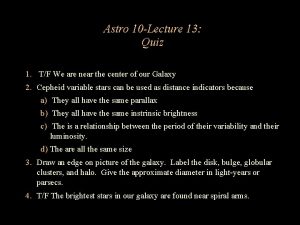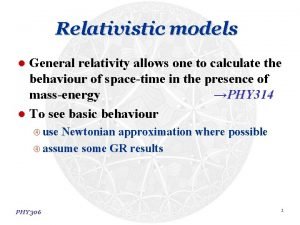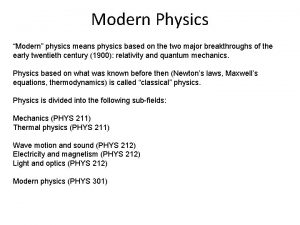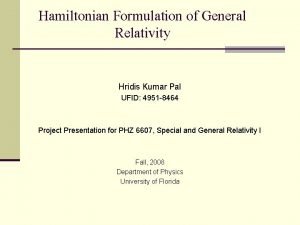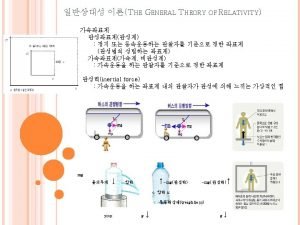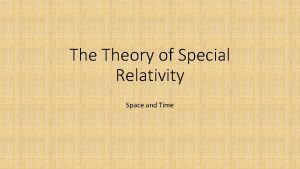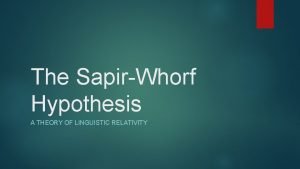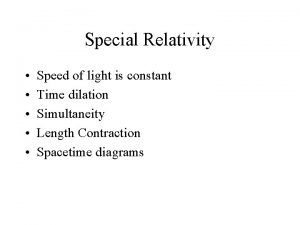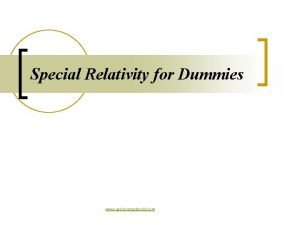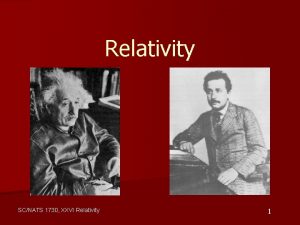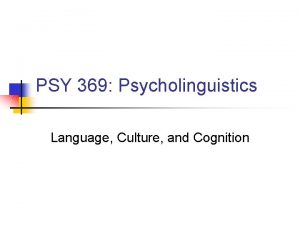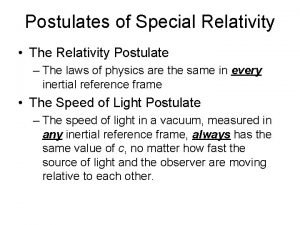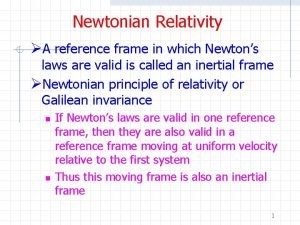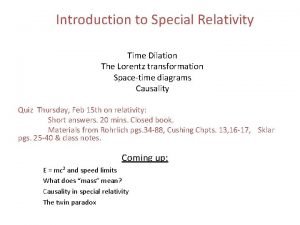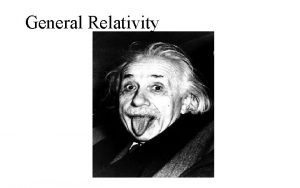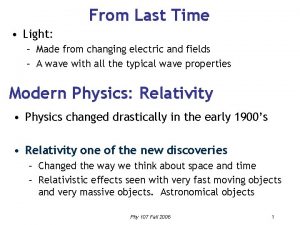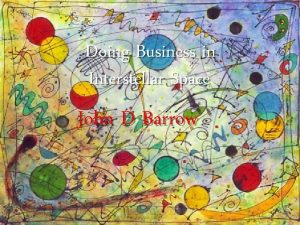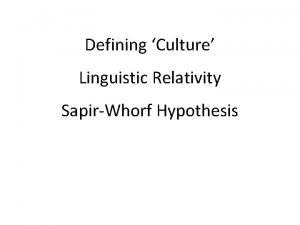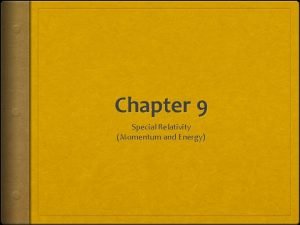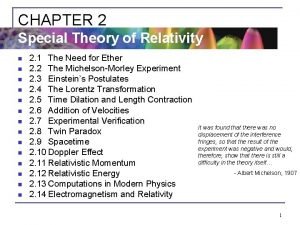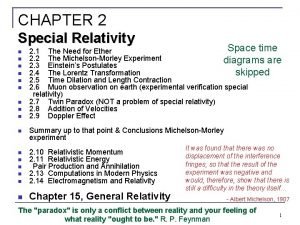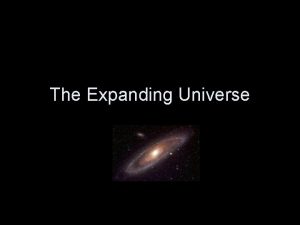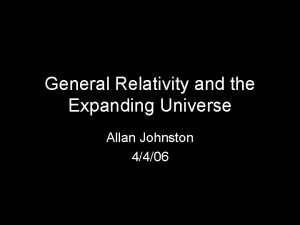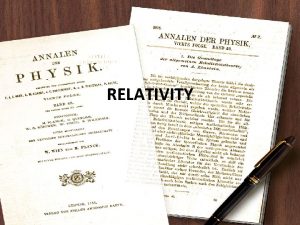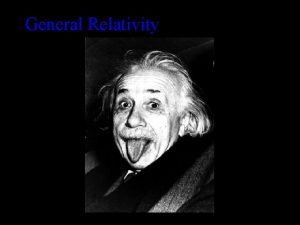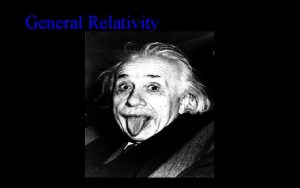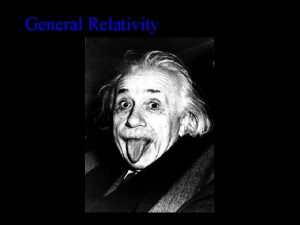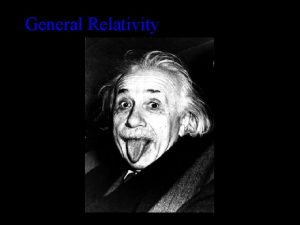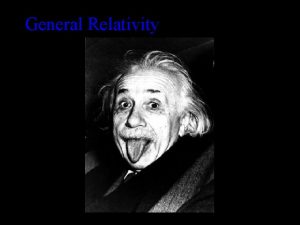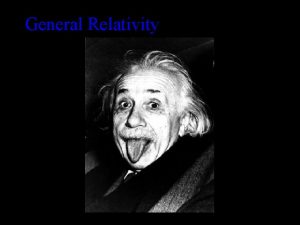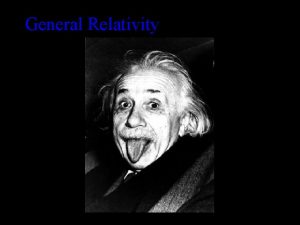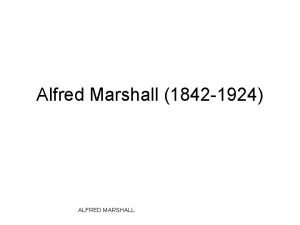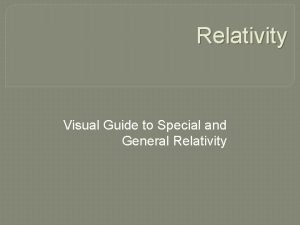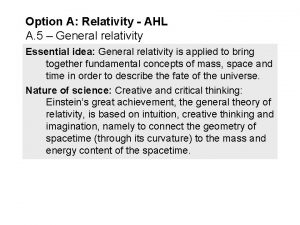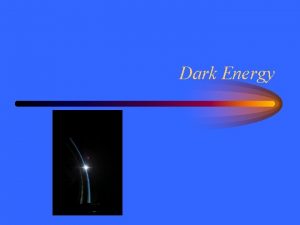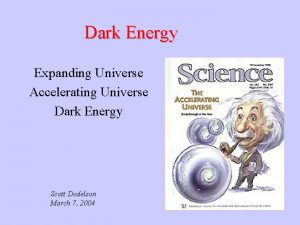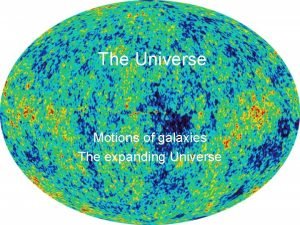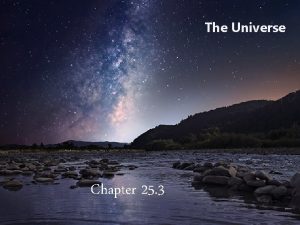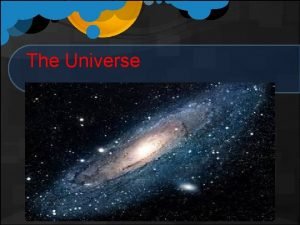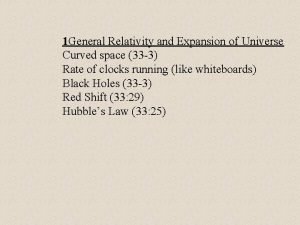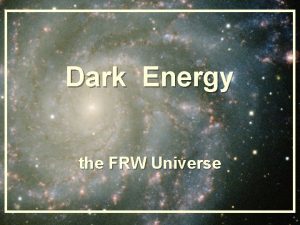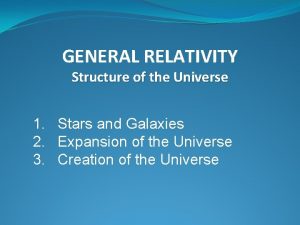General Relativity and The Expanding Universe Michael Marshall




































- Slides: 36

General Relativity and The Expanding Universe Michael Marshall & Michael Szopiak “Matter tells space how to curve. Space tells matter how to move. ” – American physicist John Wheeler

Special Theory of Relativity 2 Postulates (Einstein, 1905): 1) The form of the laws of physics is the same in all inertial reference frames 2) The speed of light has the same constant value for all inertial observers General Theory of Relativity Equivalence Principle (Einstein, 1907): In a small region of spacetime (locally), it is not possible to distinguish operationally between a frame ‘at rest’ in a uniform gravitational field and a frame uniformly accelerated through empty space

Consequences of the Equivalence Principle 1) Inertial Mass = Gravitational Mass 2) Light is affected (‘bent’) by gravitational fields

Inertial Reference Frames Performed locally, no experiment inside the free-falling elevator could distinguish it from an inertial frame. Since gravitational and accelerated frames are equivalent, we cannot determine an absolute inertial frame.

Mach’s Influence on General Relativity It was supposed that Mach’s concept (of an inertial frame determined with a reference to the fixed stars) was incorporated into General Relativity – but these showed otherwise. De Sitter’s (Empty, Expanding) Rotation) Gödel’s (Absolute

Experimental Tests • Einstein’s theory of general relativity and the equivalence principle are tested with three well known experiments – Bending of light rays by a gravitational field – Gravitational red shift of Light – Advance of the perihelion of Mercury

Bending of Light Rays by a Gravitational Field • Mass equivalence principle – “The form of each physical law is the same in all locally inertial frames. ” (Harris 45) • Therefore, if light bends in an accelerating frame, any experiment should conclude that light bends in a gravitationally equivalent frame

Light Bends in an Accelerating Frame

Bending of Light Rays • The mass equivalent principle provides another reason for thinking light would bend in a gravitational field • E = mc 2 can be rearranged to m = E/c 2 • Therefore, light (which carries energy) has an effective ‘mass’ in a gravitational field


The Experiment • Travel to Russia and South America • Observe solar eclipse • Calculate apparent position of star at point 2 and the actual position of the star at point 1

Einstein’s Prediction • In a 1911 paper, he postulated the bending of the starlight to be about 0. 83” (seconds of arc) for the given example • Einstein recognizes theoretical problem • Revised prediction of 1. 7” before any experiment was performed • Actual data from 1919 confirms Einstein’s prediction of 1. 7”

An Elegant Theory “Now I am fully satisfied, and I no longer doubt the correctness of the whole system, whether the observation of the eclipse succeeds or not. . . The sense of the thing is too convincing. ” (Einstein, 1914) “When I was giving expression to my joy that the results coincided with his calculations, he said quite unmoved, ‘But I knew that theory was correct’, and when I asked, what if there had been no confirmation of his prediction, he countered, ‘Then I would have been sorry for the dear Lord – theory is correct. ’” (Einstein’s student, 1919)

Interesting Questions • What if the expedition had gotten the initial results of 1. 7” before Einstein adjusted his numbers? • How do you think this would have affected the scientific community’s view of general relativity? • How does the concept of falsifiability connect to this experiment if the expedition calculated 1. 7” before Einstein adjusted his prediction? • Even if Einstein were to correct his error, would his theory have the same strength? – Should it have the same strength?

Gravitational Redshift The Doppler Effect (Revisited)

Gravitational Redshift The Doppler Effect (Revisited)

Gravitational Redshift The Doppler Effect (Revisited) Real-World Example: Global Positioning System (GPS)

Advance of the Perihelion of Mercury • Newtonian mechanics fails to properly predict orbital paths for high gravitational fields – Mercury provides the perfect example • (Exaggerated picture)

Perihelion Precession • Over one century, Mercury’s orbit appears to advance 5600” of arc per century • 5026” of arc are due to wobbling of Earth on axis • 531” of arc are due to perturbation from planets • Newtonian mechanics cannot explain about 43” of the precession of Mercury • General relativity is able to account for the missing 43”

General Relativity’s Success • Three experiments validate general relativity • The elegance with which general relativity explains each of these difficult phenomena gives it strength as a theory

Review of the Classical Universe • Newton believed the universe to be – Euclidean (have zero curvature) – Infinite – Finite amount of matter • Then changed position to uniform distribution of matter throughout an infinite space in order to prevent collapse of the universe (“Fixed Stars”) – The stability of the universe was in question – Newton postulated that our universe is stable because of the action of God

Olbers’ Paradox • Heinrich Olbers, an eighteenth century German astronomer, asks the question: – Why is it dark at night? • This question seeks to understand what it would mean if the universe is actually infinite in both mass and size. • Olbers suggests that the sky should appear as bright as the noonday sun.

Olbers’ Paradox • The sky is not as bright as the noonday sun! • Thus, we have a contradiction when we say we have an infinite, static, homogeneous universe and a sky that is not always bright. • This paradox lacked a solution for over 100 years, and led many to research a finite universe.

A Review of Curvature • • Metric 2 dimensions are easier to conceptualize Then you can generalize to higher dimensions Geodesics are straight lines in a space

Einstein’s Static Universe

Friedmann’s Solutions To Einstein’s Field Equations

Possible Universes: Solutions To Einstein’s Field Equations

Lemaître’s Universe: A Big Bang ü Finite past – expanded from a hot, dense beginning ü Positive curvature ü Positive cosmological constant Λ > ΛE

Vesto Slipher • From 1912 to 1925, Slipher measured spectral lines of light from distant galaxies • Red shift! • Unique spectral lines • Great majority of galaxies are receding • Did not appear to be random

Edwin Hubble • American (1889 -1953) • Had much more accurate ways of telling distance • By finding independent determinations of distances to distant galaxies, he determined that the recessional velocity of a galaxy is directly proportional to its distance from the Earth

Hubble Constant • • Doppler-shift Hubble’s discovery Hubble’s Law Age of the Universe – 13. 7 Billion Years

Hubble’s Law • Space is expanding • The universe is not static • Each observer perceives himself as the center of the universe • Universe’s expansion is slowing down, which implies the universe used to be more compact – Supports notion of Big Bang

Olbers’ Paradox (Revisited) • Problem of red shifting • Problem of the beginning – The light from distant stars would not be in – Olbers’ paradox the visible spectrum relies on the notion that light has had an • Problem of Hubble infinite amount of radius time to reach the – If recessional velocity Earth is equal to the speed – Since Hubble’s Law of light, then there supports the Big are parts of the Bang, then the universe we can http: //www. youtube. com/watch? v=gx. J 4 M 7 ty. L universe has not never know about RE

Dark Matter • Interestingly, it appears that there is not enough mass for the universe to be expanding like it is. This fact has led to the postulation of dark matter. – Dark matter is matter that we do not ordinarily encounter, but its postulated affects can be observed through gravitational lensing

A Modern Model of the Universe ² Our Galaxy: Disc-shaped; 100, 000 ly wide in diameter ² Cosmic Background Radiation: T = 2. 7 K ² Black Holes: Strong gravitational field (when a massive body undergoes gravitational collapse) is dense enough so the escape velocity is greater than the speed of light ² The Multiverse: Parallel universes?

Works Cited Barrow, John D. The Book of Universes: Exploring the Limits of the Cosmos. New York: W. W. Norton & Company Inc. , 2011. Harris, Randy. Modern Physics. 2 nd ed. San Francisco: Pearson/Addison Wesley, 2008. Print. Kehoe, Robert. “Ch. 4 Relativity. ” Phsyics. smu. edu. Southern Methodist Univeristy, May 2006. Web. 04 Apr. 2013. http: //www. physics. smu. edu/kehoe/1301 S 06/Ch 4 Relativity. pdf. >. Nave, Carl Rod. "Hyper. Physics. " Hyper. Physics. Georgia State University, Aug. 2000. Web. 08 Apr. 2013. <http: //hyperphysics. phy-astr. gsu. edu/hbase/hframe. html>. Minute Physics You. Tube Videos: Olber’s Paradox: http: //www. youtube. com/watch? v=gx. J 4 M 7 ty. LRE Multiverse: http: //www. youtube. com/watch? v=Ywn 2 Lz 5 zm. Yg Pictures (from Internet): http: //www 8. garmin. com/graphics/24 satellite. jpg http: //marketplayground. com/wp-content/uploads/2010/12/garmin-nuvi-1340 -sat-nav-garmin-nuvi-1340 -gps. jpg http: //www. astro. virginia. edu/class/whittle/astr 553/Topic 01/t 1_slipher. html http: //scienceworld. wolfram. com/biography/Hubble. html
 Special vs general relativity
Special vs general relativity General vs special relativity
General vs special relativity Special vs general relativity
Special vs general relativity Expanding universe
Expanding universe Is the universe expanding or shrinking
Is the universe expanding or shrinking Expanding universe
Expanding universe Expanding ever universe 18
Expanding ever universe 18 The universe expanding than should be
The universe expanding than should be The universe expanding than
The universe expanding than The universe expanding than should be
The universe expanding than should be The universe expanding faster than
The universe expanding faster than Cosmological redshift equation
Cosmological redshift equation The universe expanding faster than
The universe expanding faster than Expanding universe
Expanding universe Expanding universe
Expanding universe General relativity equation
General relativity equation Define modern physics
Define modern physics Hamiltonian formulation of general relativity
Hamiltonian formulation of general relativity General theory of relativity
General theory of relativity Theory of general relativity
Theory of general relativity Time dilation theory of relativity
Time dilation theory of relativity Sapir-whorf hypothesis definition
Sapir-whorf hypothesis definition Special relativity
Special relativity Relativity for dummies
Relativity for dummies What is special relativity
What is special relativity Relativity definition
Relativity definition Sapir whorf hopi
Sapir whorf hopi Special relativity postulates
Special relativity postulates Newton's relativity theory
Newton's relativity theory Law of relitivity
Law of relitivity Principle of equivalence
Principle of equivalence Galilean relativity
Galilean relativity Time relativity interstellar
Time relativity interstellar Whorf hypothesis
Whorf hypothesis Momentum special relativity
Momentum special relativity Lorentz transformation equation
Lorentz transformation equation Relativity
Relativity
